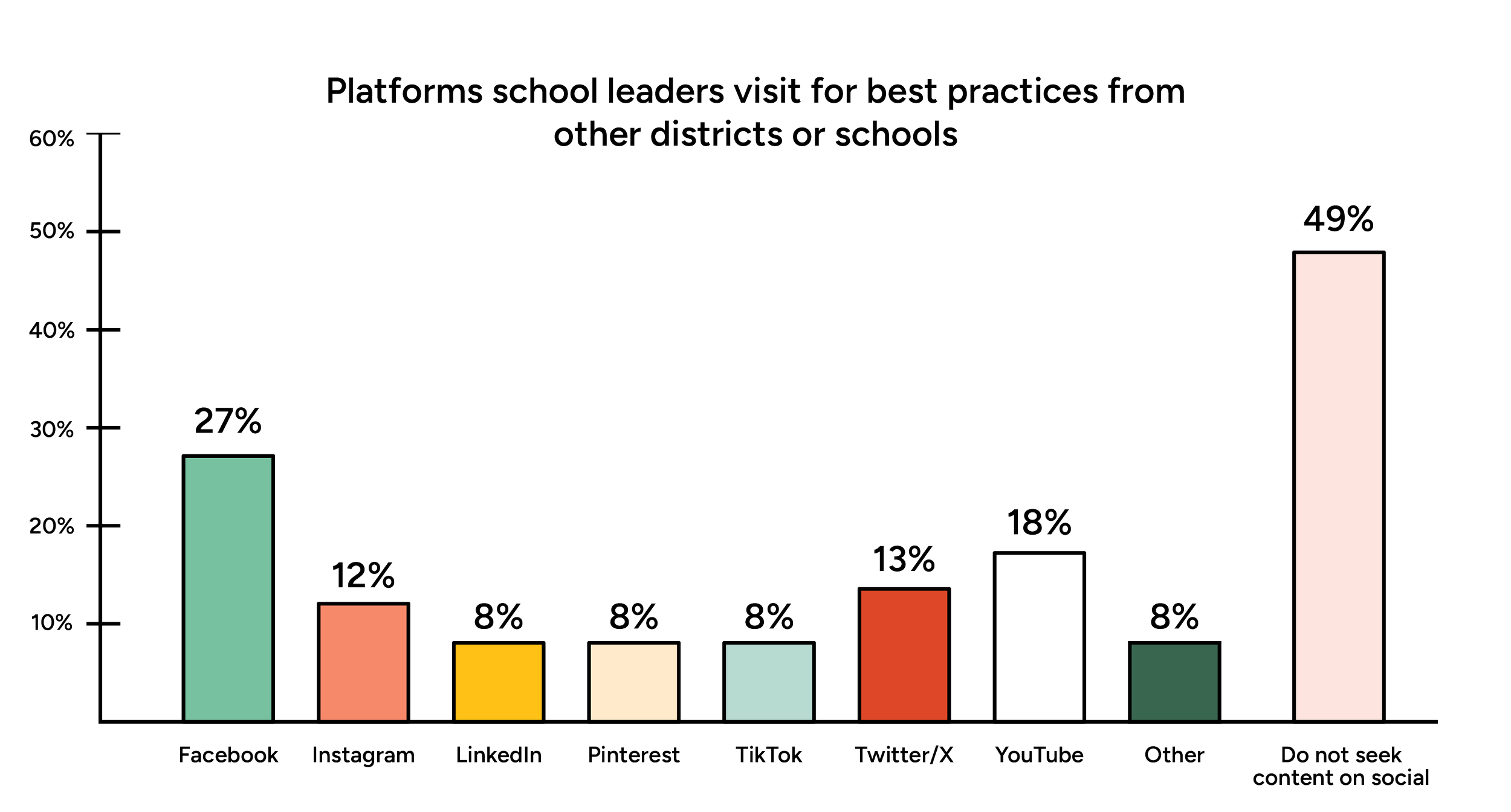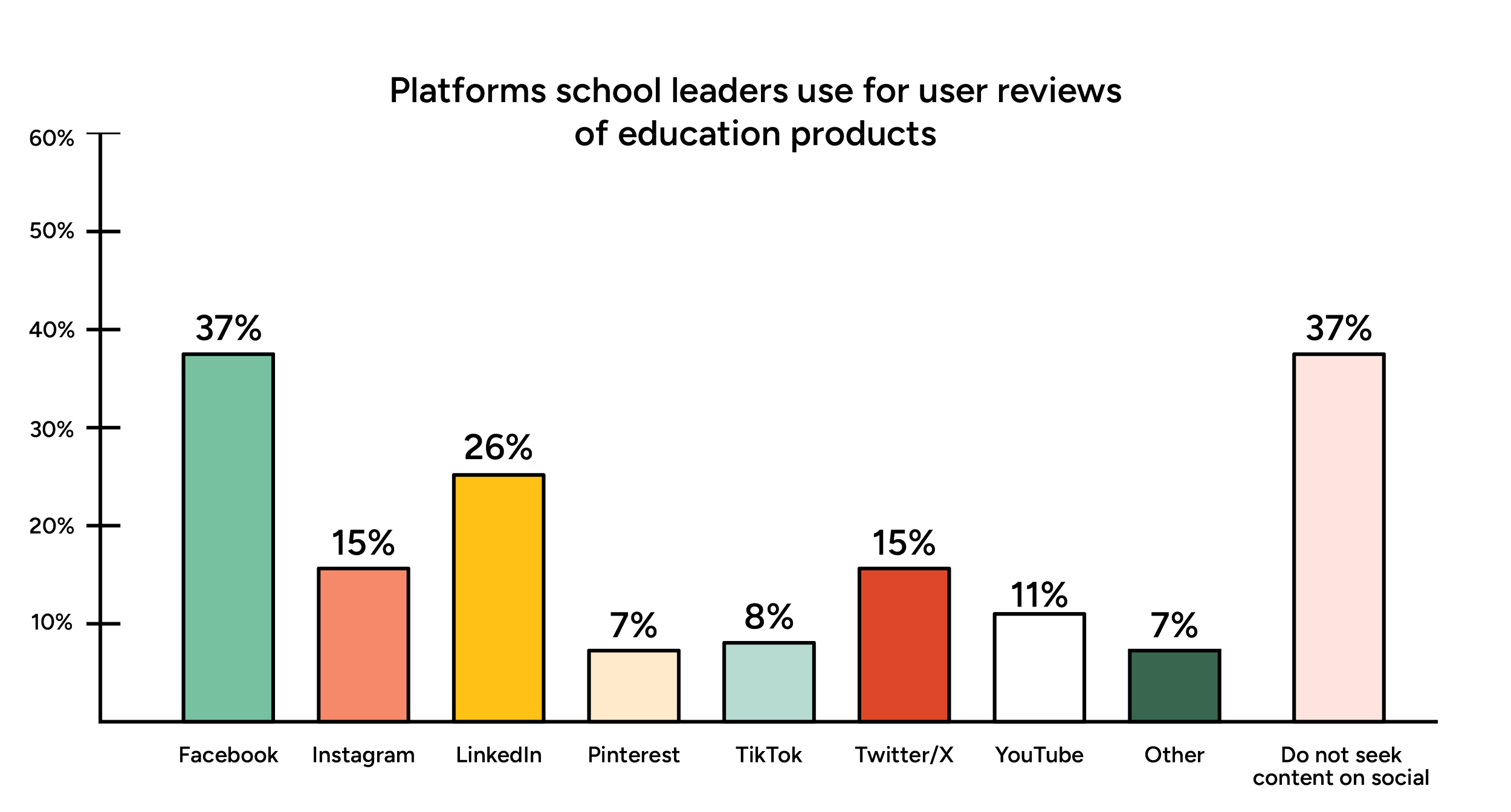In the high-intensity and somewhat isolating world of education leadership, social media plays a crucial role in building awareness and engaging with school and district leaders. Different social media channels help them connect with other education leaders, discover new industry best practices, and, you guessed it, learn more about new and interesting EdTech tools that can solve their most pressing challenges. As EdTech marketers who consistently aim to reach and engage education administrators, we know this audience isn’t always the easiest to find online.
Our CEO Elana Leoni was recently asked to provide insight on a recent EdWeek Market Brief survey about how K-12 education leaders use social media. Given the complexity of the K-12 ecosystem and the ever-changing world of social media, we've provided some additional explanations and thoughts to complement this data. We hope this informs you about the unique opportunities to reach and engage school and district leaders on Facebook, LinkedIn, YouTube, Twitter/X, Pinterest, TikTok, and Instagram.
How To Interpret the Data
In the recent EdWeek Market Brief survey, researchers asked school and district leaders what social media platforms they used to get their jobs done. Before we get into the data and insights, it’s worth emphasizing that when considering social media and anyone's goals or intent, you have to match it to the social media channel's primary behaviors. What do people naturally do on each social media channel? What do they expect to get when they spend time on each channel? Chances are, their top goals aren't doing product research or even lesson planning.
The magic of social media is that if done well, you can help your audience do and learn things that don't 100% map to the original intent of why someone is spending time on social media initially. So, while this data reveals some helpful insights about school leaders’ behavior on social media, always take into account WHY someone spends time on a certain social media channel and then come up with a strategy that aligns with that intent. Then, sprinkle in helpful things that you can surface up to them as you use social media to build a relationship with them over time.
With that in mind, let’s dive into the data. Overall, the survey results found that Facebook and YouTube are the most relied-upon resources when K-12 leaders are looking for best practices from other districts and schools and gathering user reviews of education products they’re considering purchasing.
Platforms school leaders visit for best practices from other districts or schools. Source: EdWeek Research Center nationally representative August 2023 survey of 218 district leaders and 271 school leaders.
Platforms school leaders use for professional networking. Source: EdWeek Research Center nationally representative August 2023 survey of 218 district leaders and 271 school leaders.
Platforms school leaders use for user reviews of education products. Source: EdWeek Research Center nationally representative August 2023 survey of 218 district leaders and 271 school leaders.
How School Leaders Use Social Media
Beyond the headlines, there are quite a few lessons we can learn from the data above.
1. The Power of Community on Facebook
One of the driving forces behind the popularity of Facebook among education leaders is its ability to foster networks and communities through private groups. These private groups offer a safe space for administrators to share challenges and seek advice anonymously. Note: Unlike LinkedIn, where professional titles are prominently displayed and updated, Facebook allows school and district administrators to engage and consume without revealing their role. In a profession where caution and privacy are essential, the comfort of anonymity allows educators to feel more at ease and willing to share and exchange or just lurk and consume.
2. YouTube's Intentional Content Search
On YouTube, users can be very intentional about the content they view. Unlike platforms like TikTok designed for entertainment with endless scrolling, YouTube caters to users looking for specific information. District and school leaders utilize YouTube to gather insights into what other educational institutions are doing well and where they might be facing challenges. This intentional approach aligns with the risk-averse nature of administrators who prefer platforms they are familiar with and can give them quick and easy answers with how-to videos that hopefully demystify the products and services they're researching.
3. Instagram's Rise in Popularity
Although the survey data ranked Instagram fairly low in all categories, Instagram is gradually gaining traction among district and school officials, with engagement increasing through features like Reels and Stories. Educators use this platform to provide glimpses into their daily lives, showcase products they find valuable with tips and strategies, and communicate and share experiences. We expect Instagram to continue to grow its usage with educators and education leaders in the future. And as Instagram rises, so will TikTok.
4. Pinterest's Limited Role in Education
On the flip side, Pinterest, which is often associated with planning and visual searches, has limited appeal among education leaders. Pinterest is more of a visual search engine than a social network. It’s a great way to visually display resources, and most users go to Pinterest with the intent to plan something (usually far in advance). As such, Pinterest’s primary use in education revolves around planning. Specifically, educators use Pinterest to gather resources into boards to plan curricula and lessons (and they may get inspired to design their bulletin boards, doors, and classroom spaces).
Social Media Grows Trust and Ensures Product-Market Fit
Unlike traditional short-term lead-generation strategies, social media requires a long-term commitment to generic, consistent engagement and building trust with your target audience over time. The most successful EdTech marketing comes from a deep understanding of their target audience, and there is no better place to do that than on social media (and we’d also argue that you cannot achieve a true product-market fit without this deep understanding of your target audience).
Want more ways to get to know the information you need to capture the attention of school leaders? Our Extended 2024 EdTech Marketer’s Planner offers insights into both the K12 buying cycle and the school schedule; as you create content, this calendar and templates will help you plan valuable content at the best times to connect with these school leaders.
This post was created using a combination of the article in EdWeek Market Brief written by Alexandria Ng, and Elana and Jordan from our team.








